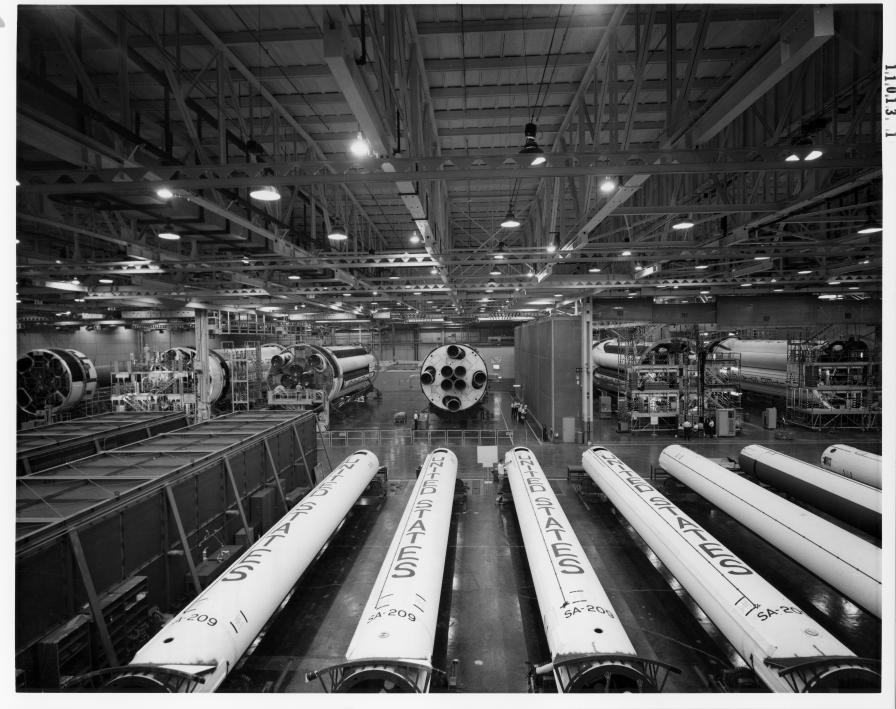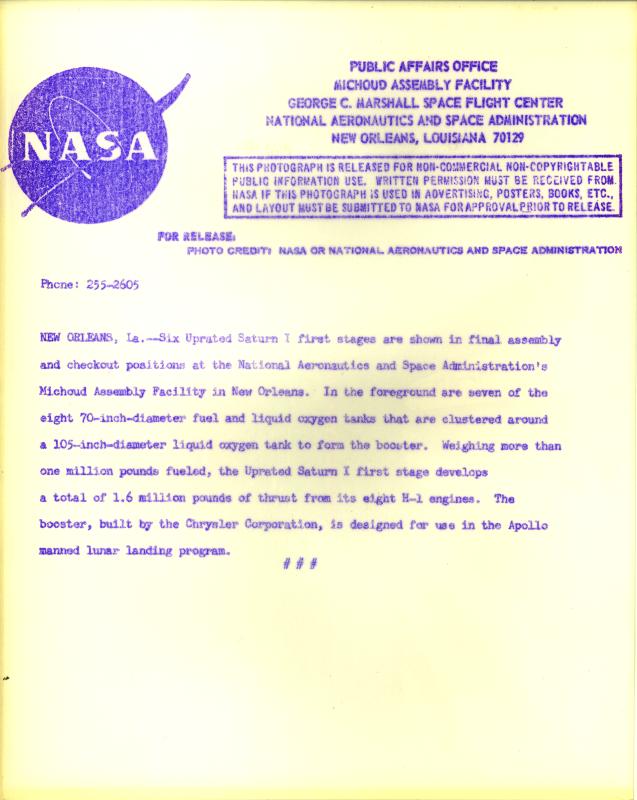SA-209 Assembly
Here's a photo of S-IB stage assembly at Michoud, featuring SA-209's propellant tanks. Built but never used, SA-209 is the most complete of the two surviving Saturn IBs and resides in KSC's Rocket Garden.
The stage at the center of the picture must be S-IB-1 or S-IB-2, as its inboard engines have no partial aspirators. To its immediate left and immediate right would have to be S-IB-3, S-IB-4, or S-IB-5, as S-IB-6 and subsequent stages had white fuel containers, rather than the black and white paint job. I'd guess that the remaining two nearly-completed stages are S-IB-6 and S-IB-7, with S-IB-8 being prepped for clustering on the far left.
Looking closely at the full-resolution photo, I see that the far-right booster is in fact S-IB-7. The other boosters' serial numbers are difficult to read, but the booster to S-IB-7's left is either S-IB-3 or S-IB-5 and the second booster from the left looks like either S-IB-6 or perhaps S-IB-8 (in which case the far-left booster would probably be S-IB-9 being prepped for clustering).
Note that the booster's color scheme was changed subsequent to the test firing of S-IB-2 in Marshall's Static Test Tower. During the static test firings of S-I-10, S-IB-1, and S-IB-2, fuel tank F-3 developed permanent ripples which "were formed as a result of thermal stresses within the tank wall. Radiant energy from the exhaust plume was absorbed more readily by the black painted areas of the tank. This heat was initially dissipated to the fuel within the tanks, but as the fuel level dropped, a significant difference in temperature was noted between black painted portions of the tank and the white painted areas. Thermal stresses resulting from this temperature differential exceeds the structural limits of the tank in local areas and causes the ripples to occur" (Saturn S-IB Stage Final Static Test Report - Stage S-IB-2).
The report, published 27 August 1965, goes on to suggest that tanks F-3 and F-4 be painted white for static testing. Of course, it'd be silly to paint the tanks back to black after static firing, and it would be unsightly to have two fuel tanks white and two tanks black, so they solved the issue by painting all of the fuel containers white. According to Saturn I/IB by Alan Lawrie, S-IB-5 was undergoing assembly at virtually the same time as S-IB-2's test firing (S-IB-5 was positioned in the main assembly cluster fixture on 15 July 1965, 5 days before S-IB-2's test; S-IB-5's tanks were clustered starting August 18, with the S-IB-2 report being published 9 days later). S-IB-6 did not begin clustering until 25 October 1965, and so the change in the paint job was implemented with that stage.
Having spent this much time trying to determine the identity of the stages in this picture, I decided to continue with this research (maybe too much information can be a bad thing :-) I see that S-IB-2 arrived back at Michoud after static test on 7 August 1965 and that S-IB-1 departed for Kennedy 9 August 1965. Thus, the stage at the center of the photo must be S-IB-2: S-IB-1 left Michoud by August 9, but clustering on S-IB-6 did not begin until October 25.
Click image for a 3961x3134 pixel version of this image in a new window, or
click here for a 12003x9498
pixel version of this image in a new window.
NASA photo 11013-1. Scan by heroicrelics.
Here's a scan of the back of the picture:
Click image for a 2403x3016 pixel version of this image in a new window.
NASA photo 11013-1. Scan by heroicrelics.
It reads
NEW ORLEANS, La. - Six Uprated Saturn I first stages are shown in final assembly and checkout positions at the National Aeronautics and Space Administration's Michoud Assembly Facility in New Orleans. In the foreground are seven of the eight 70-inch-diameter fuel and liquid oxygen tanks that are clustered around a 105-inch-diameter liquid oxygen tank to form the booster. Weighing more than one million pounds fueled, the Uprated Saturn I first stage develops a total of 1.6 million pounds of thrust from its eight H-1 engines. The booster, built by Chrysler Corporation, is designed for use in the Apollo manned lunar landing program
# # #


